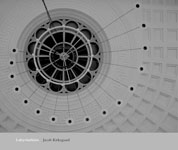|
|
 |
Dusted Reviews
Artist: Jacob Kirkegaard Album: Labyrinthitis Label: Touch Review date: Jan. 15, 2009 |

|
|
|
 |
On Maryanne Amacher’s Sound Characters (Making the Third Ear), the CD’s output is crafted specifically to elicit sounds that come from within the ear. The phenomenon is called otoacoustic emissions (OAEs), where the inner ear is manipulated by external sound in such a way that its own vibrations become audible to the listener. Distorted product OAEs, or DPOAEs, involve tones generated at a specific ratio, causing a natural distortion effect on the OAE, and subsequently a third, lower tone in the listener’s ear. Amacher’s use of OAEs invited listeners into the creation process, but the disc was, in the end, a solitary endeavor - it is impossible for the naked ear to hear another human’s OAEs, so each listen of Sound Characters created a performance for one, even with others in the same room.
Jacob Kirkegaard aims to do Amacher one better. Labyrithitis, named for a disorder of the inner ear, also entails the playback of tones to elicit DPOAEs in the listener’s ears, but the conceptual kicker here is that all of the sounds on the disc evolved from a single series of source tones: DPOAEs recorded (using highly amplified microphones) from Kirkegaard’s own ears. On Labyrithitis, Kirkegaard uses his own DPOAEs to create the phenomenon in the ears of his listeners, presenting the tones at the 1:1.2 ratio required to generate the microscopic audio events. Kirkegaard begins with two tones, then, after a time, replaces the pair with a third, played at the frequency at which the prior DPOAE was created in the ear. Kirkegaard then uses the 1:1.2 ratio again to create a new DPOAE, and the disc continues in this manner for almost 40 minutes.
Since a DPOAE is always lower in pitch than the tones that create it, each new tone on Labyrithitis is lower than those that preceded it, though Kirkegaard appears to vary it up so that the projection isn’t too easy to predict. The experiment results in a beautiful collage, with shimmering intersections of sounds entering and leaving the mix. (Speaker arrangement and any number of factors likely play a part in the process.) The rich drones, sliding across each other like bolts of silk, are attractive enough, but the smaller sounds, the overtones and DPOAEs created by the carefully paired pitches, are what make for Labyrithitis‘ most interesting output.
To make music that interacts with its listener is quite a feat. To do so in a way that results in sound that’s as alluring aesthetically as it is conceptually is an even bigger coup. With Labyrithitis, Kirkegaard has achieved the latter, engaging with an idea that is draped in academic formality in its explanation, but in practice echoes the golden sky above the ivory tower more than any discussion going on inside. Other musicians may aim for shaking booty, heads banging, or feet that won’t stay still, but Kirkegaard looks to make ears sing, and the duet created by the output of his ears and those from the listeners’ is such a joy that when Labyrithitis ends, we all ought to pat ourselves on the back for a job well done.
By Adam Strohm
|







